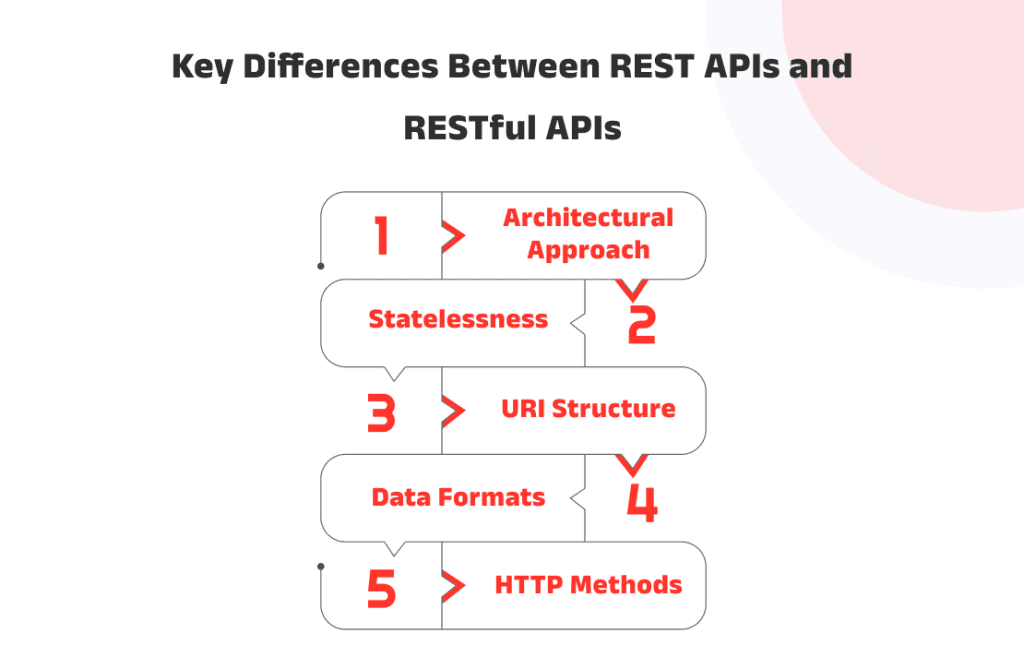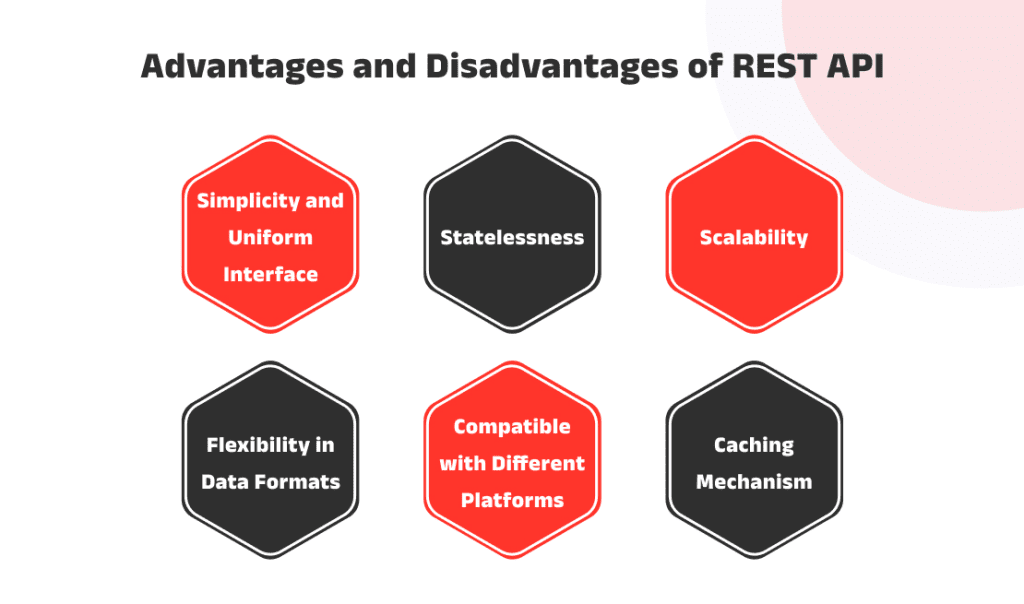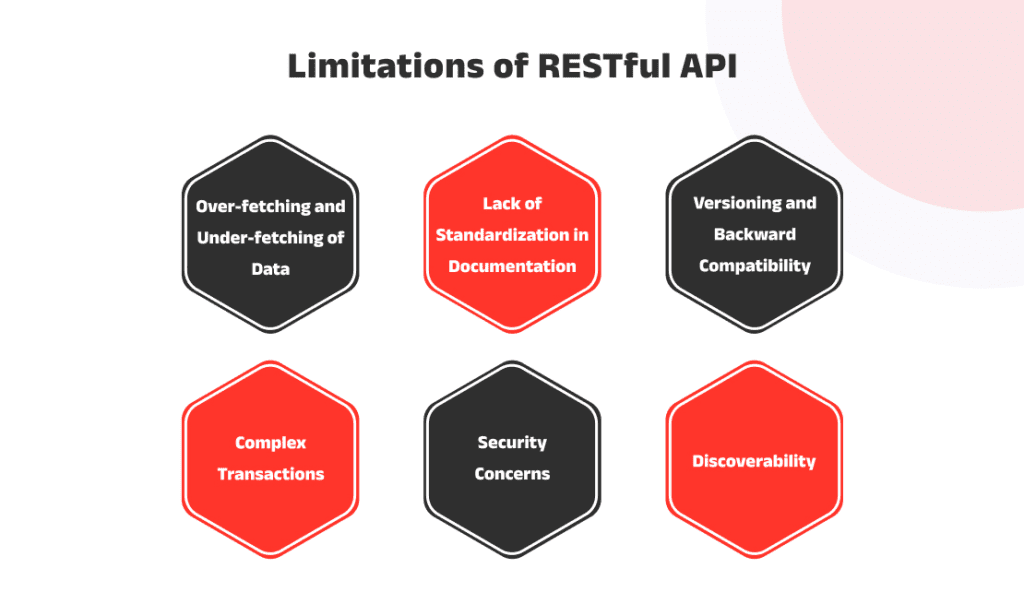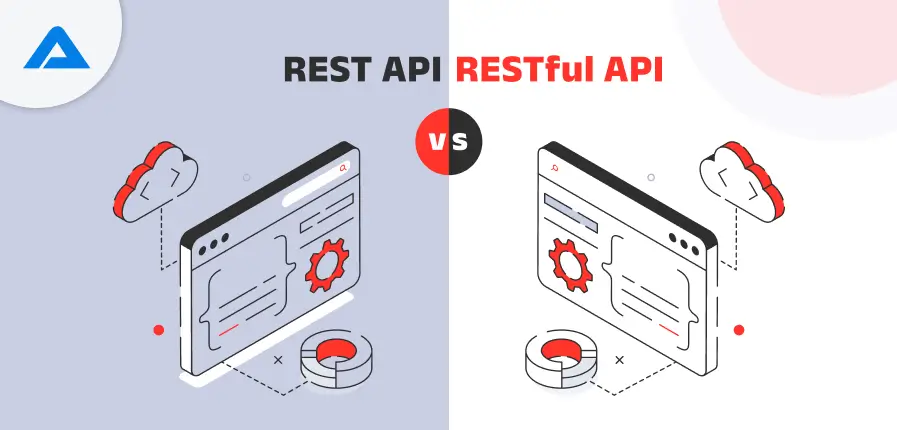Read our complete guide to discover the difference between REST APIs and RESTful APIs for web development. Find out about their structure functions, their capabilities, and the best methods for creating efficient web applications.
APIs (Application Programming Interfaces) have become indispensable for creating web-based applications communicating with various data sources and services. Two common approaches to creating APIs are REST and RESTful APIs. Although these terms seem similar, they have distinct differences in their structure, function, design, and best practices.
Although the distinction between the two may not be obvious at first glance, it’s not just a question on Stack Overflow. You’re likely to hear somebody raising their voice over the issue while working with your web development solution team and discussing patterns of software architecture to build the software.
Let’s make it clearer. There’s no major distinction between RESTful and RESTful about APIs. But they’re utilized for different purposes. REST is a collection constraint, whereas RESTful refers to an API that conforms to the restrictions. It is used extensively in software, web services, and other applications.
In simplest terms, “REST” (Representational State Transfer) is an architectural style, while RESTful is a term used to describe web services that use this style.
Defining REST API
REST isn’t a particular technology or protocol but an architectural set of principles defining how web standards, including HTTP or URIs, must be utilized. The fundamental concept behind REST is built on using resources as entities that can be recognized and modified over the internet. The REST principles include:
1. Statelessness: Applications that use REST are not stateless. This means that for each request made by a client, the server has all the necessary information to comprehend and complete the request. The server doesn’t store any data about the client’s status between each request.
2. Server-Client Architecture: It separates server and client into separate entities, which allows them to develop independently. This helps with scalability and makes the overall architecture simpler.
3. Unified Interface: The RESTful API provides the same interface and uniformity, making it simpler for users to comprehend and use the APIs. This is accomplished by using a set of restrictions that include resource identification using URIs and a representation of resources using the standard HTTP methods.
Key Characteristics of REST
REST is distinguished by a number of significant characteristics that help to make it simple and efficient:
1. Resource: in REST, everything is regarded as a resource, comprising data, objects, or even an object. The resources are identified using URIs (Uniform Resource Identifiers).
2. Representation: Resource representations can include various depictions (e.g., JSON, XML). Clients use these representations more than with the resources themselves.
3. Stateless communication: Each request from an individual client to a server is distinct and includes all the data the server requires to complete the request. There is no session data saved in the servers between each request.
4. State Transfer: when a browser interacts, it will transfer the resource’s state. This could include modifying the resource’s state or asking for an image of the resource’s state.
5. HTTP Methods: APIs that use RESTful utilize traditional HTTP techniques (GET or POST, PUT, or DELETE) to carry out the operations of resources. Each method is significant and linked to the CRUD (Create, Read, Update, delete) operations.
Introduction to RESTful API
A RESTful API implements the concepts and constraints that are defined by REST. It is an architectural design style to create networked apps that emphasizes simplicity, scalability, and reliability. When creating RESTful APIs, it is essential to follow RESTful API, certain rules and restrictions are to be observed:
Principles and Constraints of RESTful API
1. Client Server: As in REST, the clear separation between server and client is kept, allowing them to grow independently.
2. Statelessness: The client’s request to an API RESTful is self-contained and contains all the data the server requires to complete the request. The server doesn’t store any information about the state of the client.
3. Unified Interface: RESTful APIs offer a uniform interface using the same principles for resource identification, representation, and manipulation.
Characteristics that make An API RESTful
1. Resources Identification: The resources in RESTful API are identified using URIs. These URIs are unique identifiers to identify the resources, allowing clients to connect with them.
2. Resource Representation: Resources may have different representations, like JSON and XML. Users interact with them rather than directly altering the resource.
3. Stateless Communication: RESTful APIs adhere to the statelessness principle, which ensures that every request is completely independent and includes all the data required by the server to process it.
4. HTTP Methods: Operations for CRUD are carried out with the standard HTTP methods, which provide the user with a consistent and clear way to communicate with resources.
Understanding RESTful APIs and RESTful REST is essential for web designers and developers. REST is a set of guidelines that guide the development of reliable and scalable web services. RESTful APIs follow these guidelines to build secure and efficient web architecture applications. If you adhere to these principles, developers can design APIs that aren’t just practical and simple to comprehend and use.
Key Differences Between REST APIs and RESTful APIs

The difference between REST and RESTful APIs is in the approach to conceptualization and the implementation of the architectural principles behind REST. Although REST (Representational State Transfer) provides guidelines for the design of networked applications, RESTful APIs are the actual implementation of these concepts. The primary differences lie in their design approach, states of inertia, URI structure, data formats, and HTTP methods. Knowing these differences is essential to developers trying to navigate the complexities of web-based services since it affects the design decisions and the scalability and overall effectiveness of applications. In this article, we explore the subtleties that separate these two types, shedding some light on why they might be favored over one in developing web-based apps.
Architectural Approach
REST, also known as Representational State Transfer, functions as an architectural design style defining the fundamentals for creating scalable and reliable web services. It is defined by a resource-centric approach, which means that each component is treated as a resource whose identity is determined by a unique URI. The design is based on statelessness and encourages the independent development of servers and clients. REST utilizes traditional HTTP methods to operate on resources, focusing on using a consistent and simple interface.
RESTful APIs, on the other hand, function as the actual implementation of the REST’s architecture principles. It is implementing these principles within the context of software or a system. RESTful APIs follow the restrictions set by REST and ensure that interactions between servers and clients align with established rules. This involves defining resources, structuring URIs, selecting suitable data formats, and utilizing the standard HTTP methods for communicating.
Statelessness
In REST, the stateless nature is ensured by defining each request between the client and server as an independent, self-contained, and self-contained operation. The server doesn’t store data about the client’s state between requests. Each request made by your client’s server contains all the necessary information for the server to comprehend and respond to the request. This approach makes it easier for servers to implement, increases scalability, and ensures that every request is independent and devoid of dependence on previous requests.
RESTful APIs follow the statelessness principle, following the same principles as REST. Every request to a RESTful API is accompanied by all the data the server requires to complete the request. This makes managing the server’s structure easier and more flexible and easier to manage. Statelessness guarantees that the API can withstand interruptions because each request is unique from the previous one, and there is no requirement to save client data on the server between requests.
URI Structure
Within REST, URIs serve as unique resource identifiers and form the basis of the resource-oriented structure. URIs within REST are logical and follow a structure that outlines the relationships between resources. The typical structure is an initial URI and then resource-specific paths that allow clients to find and access resources in an established and consistent format. This ease of use contributes to the simplicity of navigating and using RESTful services.
RESTful APIs have a foundation built on these fundamentals, implementing URI design principles that align with REST’s resource-oriented model. URI design practices in RESTful APIs focus on simplicity, clarity, and sameness. Resource identifiers are organized hierarchically to show the connections between resources, creating an orderly and rational API structure. Furthermore, meaningful resource names are used to improve the API’s comprehension. The objective is to make APIs that aren’t just human-readable but also reflect the resource they refer to, which makes it easier for users to navigate and use by developers.
Data Formats
The REST structure is independent of the data format, making using a range of formats possible. The most widely used data formats are XML and JSON. XML (eXtensible Markup Language) is a flexible markup language offering a hierarchical structure to represent data. On the other hand, JSON (JavaScript object notation) is a light and readable format highly regarded because of its ease of use and parsing simplicity. The selection of these formats varies based on the particular requirements of the application as well as the preferences of the developers.
RESTful APIs, as actual implementations of REST principles, generally embrace JSON due to their light nature and compatibility with various programming languages. JSON’s simplicity and compactness are ideal for presenting specific data structures as API responses. While XML remains a viable option for RESTful APIs, JSON is now the norm in modern web development because of its widespread support and user-friendly features.
HTTP Methods
In REST, various HTTP methods are widely employed, each serving an individual purpose. The main HTTP methods are:
HTTP: Retrieves an image of the resource that is not altered.
POST: The POST creates new resources.
If: It doesn’t exist, PUT creates or updates an existing or brand-new resource.
DELETE: Eliminates a source.
Other techniques, such as PATCH (partially updating the resource) or OPTIONS (retrieving information regarding the options for resource communication), can also be used in certain situations. The flexibility of these techniques allows developers to perform various tasks on resources in an RESTful framework.
In RESTful APIs, HTTP methods are linked to CRUD (Create, Read, Update, and delete) operations to ensure consistency and clarity. This mapping is in line with the fundamentals of manipulating resources. For example:
Get: Corresponds to Read and retrieve the representation of an item.
POST: aligns with the Create to create an entirely new resource.
PUT: Maps for updating or modifying an existing resource or creating a new one.
DELETE: This enforces a Delete operation, which removes any resource.
This mapping eases the creation and comprehension of RESTful APIs—creating a standard approach for developers to communicate with and manipulate resources using known HTTP methods. The lucidity of the CRUD mapping is a significant factor in the simplicity of implementation and the ease of adoption in the development of web applications.
Advantages and Disadvantages of REST API

The REST (Representational State Transfer) is now the most famous architectural method for developing networked apps because of its ease of use in its design, scalability, and indefiniteness. Understanding the benefits and drawbacks of using REST is vital for web developers who wish to develop effective and reliable web-based services.
Simplicity and Uniform Interface
RESTful APIs provide a simple and consistent interface that uses the standard HTTP methods (GET, POST, POST, or DELETE) to carry out actions on resources. This simple interface makes it easy for developers to comprehend and utilize the API.
Statelessness
The REST statelessness promotes separate and independent requests, making implementing a server easier. Every request made by a client to a server is self-contained and contains all the necessary information to help the server understand and complete the request.
Scalability
REST is naturally capable of scaling. Its stateless nature permits simple distribution and load balancing and makes it a good choice for applications that require varying demands.
Flexibility in Data Formats
REST is not tied to any data formats, which allows the use of various representations, such as JSON and XML. This flexibility can accommodate the different needs and preferences of clients.
Compatible with Different Platforms
RESTful services are accessible and used by clients built for different platforms. This is an important benefit for heterogeneous environments.
Caching Mechanism
REST allows caching, which can improve clients’ performance by allowing them to store responses. This helps reduce the requirement for multiple requests to the server to access empty resources.
Limitations in REST API
REST is a secure and scalable architecture style for web services. However, developers must be aware of the limitations and issues. Effectively addressing these issues by implementing them with care is vital to unlock the potential of RESTful APIs in various dynamic applications.
Lack of Built-in Security
Although REST is not a security protocol, it has built-in security features; however, it relies on the transportation layer (typically HTTPS) for secure communications. To tackle this issue, developers should use other security features, like API key or OAuth.
Over-fetching and Under-fetching of Data:
REST APIs could be prone to overfetching (retrieving more data than is needed) and insufficient fetching (insufficient information retrieval). The fine-tuning of the API to accommodate particular client needs is essential to overcome this issue.
Limited Support for Transactions
REST is not built-in to support transactions that span multiple operations. This is a drawback in situations where atomic transactions are crucial.
Versioning and Evolution:
Evolving an API while ensuring compatibility with backward-compatible APIs isn’t easy. Modifications to resource structures or behavior could impact the existing clients. Strategies for versioning, like URI or header-based, must be considered carefully.
Complex Queries
In RESTful, expressing complex queries APIs may be difficult. Although simple queries are dealt with effectively, more complicated queries could require multiple requests or the addition of customized query parameters.
Discoverability
Identifying the available resources and actions within a RESTful API could be more difficult, particularly when no proper documentation exists. HATEOAS (Hypermedia to act as the engine of Application State) can help with this problem by supplying links to relevant resources.
Benefits and Drawbacks of RESTful API
RESTful APIs (Representational State Transfer) have seen widespread acceptance in creating web-based services that practically apply REST principles. Understanding the benefits and difficulties of RESTful APIs is vital for those who want to build efficient, scalable, and reliable systems.
Scalability and Performance
RESTful APIs are naturally flexible because they are stateless. This makes it easy to distribute and load balancing, making them ideal for applications with different demands.
Flexibility in Data Formats
RESTful APIs can support different data formats, including JSON, the standard common format. This flexibility allows for a variety of client needs and facilitates API integration services with various platforms and technology. Statelessness and Simplicity
The non-stateless nature of RESTful APIs makes it easier to implement server applications and increases reliability. Each client request is a complete set of necessary information for the server to comprehend and complete, which helps ensure easy and clear communication.
Uniform Interface
RESTful APIs use an identical interface, focusing on identifying resources through URIs, representing the resource, and using the standard HTTP methods (GET, POST, POST, and DELETE). This consistency enhances the accessibility and ease of use.
Caching Mechanism
The RESTful APIs can be cached, which allows clients to store responses. This helps reduce the requirement for re-connection towards the servers for identical resources and improves overall performance.
Ease of Integration
RESTful APIs are broadly used and understood, making integrating them into various applications easy. Utilizing common HTTP protocols and standard data formats makes managing communication between servers and clients easier.
Limitations of RESTful API

Knowing and addressing these issues is essential to maximizing the benefits of RESTful APIs. Despite these issues, RESTful APIs’ wide acceptance and flexibility make them a viable option for creating interoperable and flexible web services that can be used in a wide range of scenarios for applications.
Over-fetching and Under-fetching of Data
RESTful APIs can suffer from the issue of over-fetching (retrieving additional data that is not necessary) and insufficient fetching (insufficient access to data). The fine-tuning of the API design and providing a mechanism allowing users to specify the required data are essential in overcoming this problem.
Lack of Standardization in Documentation
There are conventions and tools for documentation of RESTful APIs (e.g., Swagger, OpenAPI); however, there isn’t a specific standard. The lack of a standard can result in inconsistencies and problems for API developers.
Versioning and Backward Compatibility
Developing a RESTful API and keeping backward compatibility takes time and effort. Any changes to the resource structure or behaviors could affect the existing clients. Correctly implementing strategies, including semantic versioning or making backward-compatible modifications, are essential.
Complex Transactions
Handling complex transactions that require several operations can be a challenge when using RESTful APIs. There is no built-in support for transactions that span multiple requests, which could require developers to create customized solutions.
Security Concerns
While RESTful APIs may use HTTPS to secure communications, additional security measures, such as API keys OAuth and token-based security, are typically needed. Lack of implementation or proper security procedures may expose APIs to security risks.
Discoverability
Finding the available resources and actions within a RESTful API could be easier if there is documentation. HATEOAS (Hypermedia in the form of an engine for Application State) can help with this issue by including links to other resources in API responses.
Choosing the Right API for Web App Development
Choosing the best API architecture is an essential decision when developing web applications that affect the project’s capacity, flexibility, and overall achievement. With various options, developers should consider aspects like scaling, ease of use, and compatibility with front-end frameworks. The choice between REST APIs and RESTful APIs mainly requires a deep knowledge of their benefits, drawbacks, and alignment with the project’s requirements.
Scalability
Scalability is essential, particularly as web-based applications expand in complexity and number of users. The chosen API must be able to handle increasing demands effectively. With their non-stateless nature and support for distributed architectures, RESTful APIs usually provide high scalability. Examining the possible scalability issues and requirements of the app guarantees seamless performance even during times of high demand.
Flexibility
The flexibility of the API is vital to adapt to the changing needs of projects. REST APIs, renowned for their flexibility in data formats and ease of use in communication, allow developers to adapt to a range of needs. A flexible API can incorporate new technologies, features, or modifications without disrupting the functionality.
Ease of Implementation
The ease of creating and maintaining the operation of an API is vital to growth efficiency and long-term sustainability. RESTful APIs, utilizing the same interface and employing the standard HTTP techniques, are well-known for their accessibility. A straightforward implementation process reduces development time and eliminates the possibility of errors, leading to a smoother development lifecycle.
Compatible with Front-end Frameworks
The compatibility between front-end frameworks and backend systems is crucial to create seamless interactions with the API for the backend and user interface for the Web application. Thanks to their widespread acceptance and standardization, RESTful APIs work well with different front-end frameworks, making integration easier. Ensuring the framework, you choose is compatible with front-end technologies eases the development process and improves your overall experience.
Project Requirements
Understanding the specific needs of a particular project forms the heart of the decision-making process. Different API architectures are suited to specific requirements. REST is preferred due to its simplicity; however, RESTful APIs offer more assistance for manipulating resources. By aligning the architecture chosen to the project’s functional, scaling, and performance requirements, developers can ensure that the API aligns with the goals they have set for it.
Developer Expertise
The team’s ability to develop a specific API architecture is important. If the team is already familiar with knowledge and experience with REST APIs or RESTful APIs, it will significantly impact the speed of development and code quality. Assessing the team’s capabilities aids in deciding on the right architecture to match their strengths while minimizing the learning curve and potential issues during implementation.
Long-Term Maintenance
The longevity and sustainability of the selected API architecture is crucial. Changes in the project’s requirements, technological advances, and industry standards could affect an API’s performance. Examining the long-term maintenance ability of an API ensures that the architecture chosen is flexible to new updates in the future, decreasing the chance of technical debt and making it easier to update or expand the API seamlessly.
The Key Takeaway
Ultimately, the choice between REST APIs and RESTful APIs for web app development relies on an in-depth analysis of the most important aspects. In evaluating the possibility of scaling, flexibility, ease of use, and compatibility with frameworks for front-end development, developers can make their decisions in line with the project’s specific needs.
In addition, considering the project’s specific requirements, the development team’s experience, and an emphasis on long-term maintenance will ensure a balanced decision-making process. Both APIs, REST and RESTful have distinct advantages. However, the selection must be customized to your project’s goals and team’s expertise.
A well-thought-out decision will not only help in the mobile app development solution process but also create the foundation for a flexible and resilient web application that can meet the needs of changing times and industry standards.
